
 China Tours
China Tours Tibet Tours
Tibet Tours China Theme Tours
China Theme Tours Off The Beaten Track
Off The Beaten Track Yangtze Cruises
Yangtze Cruises China Trip Planner
China Trip Planner Travel Agents
Travel Agents


We had a wonderful time in Tibet. We have learned a lot about this unique destination because of the wonderful guide Degyi who is so knowledge and always available towards our tours. We stayed at the Shangri-La Hotel Lhasa, and we would never imagine a Tibet travel could be so nice and amazing without the help of Degyi.
Also, thanks a lot to our Tibetan driver Mr.Wongdun for his safe driving and a good sense of service along the way.
We shall return Tibet in the near future!
P.B. and A. A - Europe
Tibet Travel
June 2018 (Private Tibet Journey from Kathmandu)

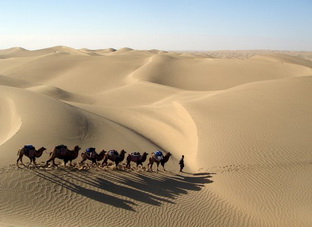 Tour Name: Taklamakan Desert Trek Tour Name: Taklamakan Desert Trek Tour Code: M69D329 Duration: 18 Days & 17 Nights Destination: Kashgar, Yarkant, Khotan, Keriya, trek Taklamakan Desert, Mazar Tagh, Kuqa, Korla, Turfan, Urumqi Features: Taklamakan Desert, China's largest desert, is the second largest shifting desert in the world only next to the Sahara. Named as "The Desert of Death", "The Desert into which who enters will not return", the Taklamakan Desert once formed the greatest obstacle to be found along the Silk Road and the camel caravan would skirt its edges, to the north or to the south, as they transported their wares from oasis to oasis and on to Khotan, Kashgar or Chinese Chang-an. Despite its reputation however the rarely-visited interior of the desert is considered to be one of the most mesmerizing beautiful sights in the East and surreal with an unearthly intensity beyond the city-dweller's imagination. These towering sand dunes and lost cities there are found occasionally the remains of ancient forests and post-fluvial riverbeds hiding amidst the hauntingly attractive desert vistas lure travelers to come and explore. This journey starts from Kashgar that traversing through Yarkant, Khotan, Keriya, and Turpan these important ancient towns on the Silk Road in the Chinese middle Asian province Xinjiang. Departure Date: You Choose! Tour Price: From $ P.P |
||
| Itinerary Day By Day: Day01 Arrival Kashgar Today you arrive in Kashgar (via Urumqi), the first major Chinese town Marco Polo visited. You will be greeted by our local guide upon your arrival and then be transferred to your hotel by a private air-conditioned car. The balance of day is on your leisure. | ||
| Day02 Kashgar (B, L) 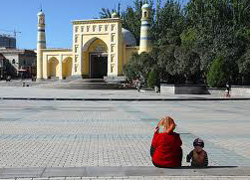 A full day guided tour in Kashgar. You will visit Idkah Mosque, the Abakh Khoja Tomb, Sunday Bazaar, the old town and Kashgar Silk Road Museum. Idkah Mosque is known for being the largest and oldest mosque in China that invites about 10,000 worshipers on every Friday. Abakh Khoja Tomb that is better known by the Chinese as Tomb of Fragrant Lady is an ancient Islamic building, where five generations of a famous Islamic master were buried. The Sunday Bazaar in Kashgar is perhaps the largest road market in Central Asia, the trip to the Bazaar offers you a good chance to experience the very good touch to the vibrant city with its local residence. After that you will explore the Old Town of Kashgar to observe these time-aged houses and people's daily life. You will also visit the Kashgar Silk Road Museum. | ||
| Day03 Kashgar - Khotan (B, L, D) 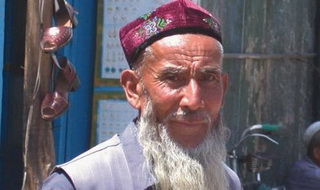 Check out in the morning and leave for Kashgar. The 520-kilometer journey, dotted with Gobi, desert and oasis, will take you about 7 hours by car. On the way, you could see the Yingisar Uigur Pocket-Knife Workshop and the 500-year Yarkant King Mausoleum in Shache County (or Yarkant County). | ||
| Day04 Khotan - Keriya (B, L, D) 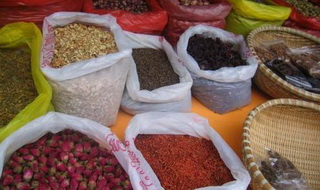 In the morning you will visit Silk Workshop in Khotan before transferring to Keriya (Yutian). Overnight at hotel in Keriya Town | ||
| Day05 Keriya - Derya Boyi (B, L, D) 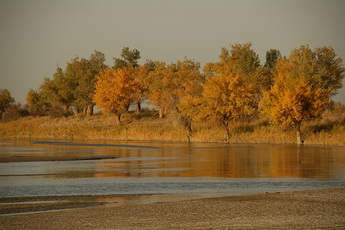 Today you will drive to Derya Boyi village which is about 220km from Keriya town into the Taklimakan desert. It takes about 10 hours by 4WD through giant sand dunes to get to this ancient and isolated village. Tonight we spend the night with a local nomadic family. Darya Boyi village is also called "Tongus Basty village" by local people. "Darya boyi" means bank of the river, as this village is located by the side of the Keriya River. The village was isolated from other towns for thousand years and the people here have maintained a unique and rich desert culture which hasn't yet been spoiled. Nobody knew people lived here until recently when the village was accidentally discovered by a petroleum expedition team. Stay and over night with the local family people | ||
| Day06 Trek Taklamakan Desert (B, L, D) 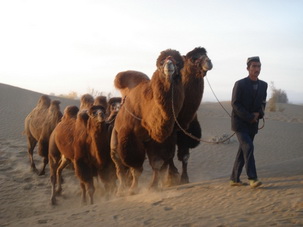 After local-made breakfast, start our trekking with the camels. Accompanied by our Uighur guides and camels we set off on our trek across the desert leaving the Keriya riverbed behind. Camping for the night | ||
| Day07-11 Trek Taklamakan Desert (B, L, D) As we travel westward the vegetation which is mainly made up of Tamarisk and Desert Poplar becomes increasingly sparse and soon we find ourselves in a landscape of soft, rolling sand dunes. At the end of our first day we should reach Karadong, abandoned in the 4th century AD until its rediscovery by Sven Hedin in 1896 and Stein in 1908. From here on our pace will be the gentle pace of the caravan and each day we will walk a leisurely 6 or 7 hours, approximately 15 to 20 km. Occasionally we have to climb up and over dunes but generally the going is quite easy with the sand on the windward side being compacted by the wind and easy to walk on. As we progress it may feel as if we are almost becoming part of the surreal landscape as we bear spellbound witness to the ever changing play of the desert light. Occasionally we come across ancient forests with desiccated trees over a thousand years old. Going far back into prehistory one would have found in the Tarim Basin a sea as vast as the Mediterranean. Later, after that great collision of continents that hoisted the Himalayas high into the sky the sea drained away, after which the whole area became forested and alive with animals such as wild deer and boar. Today in the interior, and mercifully for the Caravaneer, not even flies survive. Occasionally we will come across salt pans, evidence of water close beneath the surface - water can usually be found less than ten meters below ground level and though it is often brackish, after wells are dug by our Uighur guides, it is enthusiastically lapped up by thirsty camels. Each day we will endeavour to pitch camp mid to late afternoon leaving plenty of time to take in the sunset, enjoy desert life around the campfire, and in the spirit of Omar Khayam, marvel at the breathtakingly bright stars. Heading ever westward we will settle into the rhythm of the caravan as we make our way through a harem of untouched virgin dunes often with the sight of the Mazartagh Mountains off in the distance. Camping for the night 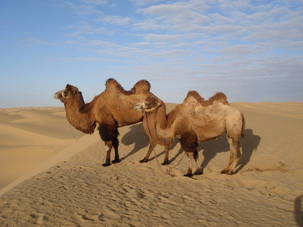 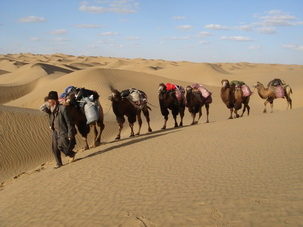 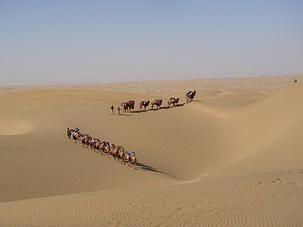 | ||
| Day12 Trek to Mazar Tagh (B, L, D) 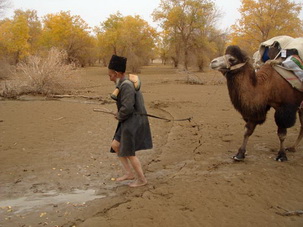 Our last day of walking brings us ever closer to the Tibetan Fort at Mazartagh, the ultimate goal of our desert caravan. After reaching the river flats of the Khotan Darya, its low banks covered by the dense fur of gnarled trees, another couple of hours walk brings us to the foot of the bare, gaunt, russet cliffs of marl and alabaster that mark the end of the Mazartagh chain of mountains. On top sits the desert crown that is Fort Mazartagh and which in its present form dates from around 790AD being built shortly after the Chinese at Khotan surrendered to the superior Tibetan forces. A smaller structure probably existed before this time and the fort is testament to the site's strategic importance dominating the once flourishing north-south trade route between Aksu and Khotan. When the Russian explorer Prejevaslky (who gave his name to the prototype wild horse but not of course to the subject of a wilder theory that he was in fact the father of Joseph Stalin!) passed this way in 1885 he dismissed the structure as the recent work of an Islamic warlord. It wasn't until the no doubt olfactory challenging descent of Stein's trusty trowel into the fort's rich refuse tip, below its eastern wall, that the site's true history was revealed. For in that hidden midden, past which Prejevalsky had ridden oblivious, was found a true treasure trove of tablets, wood slips and manuscripts, written not only in Tibetan, but also in Chinese, Khotanese, Brahmi, Sogdian, Arabaic and Uighur, together clearly showing the international nature of trade along the Silk Road at that time. We will have time in the afternoon and early evening to climb up to and explore the site and, as so many Tibetan warriors must have done in days gone by, to gaze out over the vastness of dunes and back across the distance we have trekked in the last seven days. The evening will be time for celebration as we meet our drivers for tomorrow's journey and bid farewell to the true Caravaneers who have helped us on our way so far. Camping for the night | ||
| Day13 Driven to Kuqa (B, L, D) 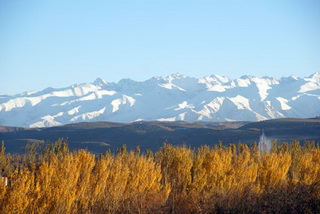 This morning we begin our journey out of the desert and head north following the Khotan Darya as it snakes its way north soon reaching a new desert highway that all being well will bring us to Kuqa before sunset. | ||
| Day14 Kuqa - Korla (B, L, D) 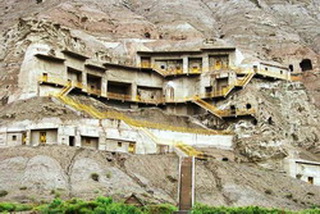 In the morning you will visit Kizil Thousand-Buddha Caves. Kizil Thousand-Buddha Caves is the earliest Buddhist art treasure trove in China, even one century earlier than the famous Mogao Grottoes. As fundamental historical remains of West Region art or Chinese Buddhist art, Kizil Thousand-Buddha Grottoes is situated at the Kizil Township which is 67 kilometers southeast of Baicheng County and 73 kilometers west of Kuqa city. It is the largest grottoes located in the west part of China which was started excavating in the 3rd century (at the end of Eastern Han Dynasty) and lasted for 500 years. The Kizil Thousand-Buddha Caves are considered to be art crystallization of the local tradition and of the central Chinese culture as well as foreign ones. This priceless encyclopedia of Qiuci culture depicted in the caves surely is surely worthwhile reading. Then you will visit The Kuqa Grand Mosque, it was first built in the 16th century and reconstructed in 1931 after being damaged by fire that first signified dominance of Islam over Buddhism in Xinjiang. It is the region's second largest mosque after the Etigar Mosque in Kashgar and has capacity for 3,000 worshipers. In the afternoon drive to Korla. | ||
| Day15 Korla - Turpan (B, L) 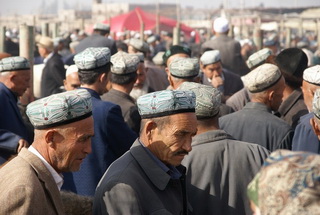 Leave in the morning for Turpan. You will be crossing the Tianshan Mountain. In the afternoon you reach Turpan and visit Karez Well and tour the Grape Valley. You will visit Karez Well and tour the Grape Valley. Karez Well is a unique underground water system invented and built by the ancient farmers of various ethnic minorities of Turpan, aiming to adapt to the basin natural environment, solar radiation and the atmosphere in the dry region. This irrigation system of wells connected by underground channels is considered to be one of the three great ancient projects in China. Your tour in Turpan will draw a close at one of the vineyard and fruit gardens in the Grape Valley. | ||
| Day16 Turpan (B, L) 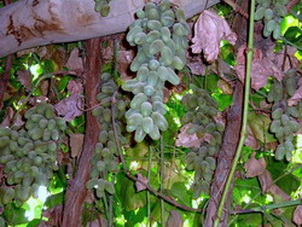 The tour today covers the Bezkelik Thousand Buddha Caves, Gaochang City Ruins, Flaming Mountain and Astana Tomb. Bezeklik Thousand Buddha Caves, have a history of over 1500 years. The oldest caves were chiseled in the 5th century A.D. and the newest were carved in the 14th century, giving the complex a construction history of one thousand years. The high quality murals are considered to be masterpieces of religious art and provide valuable information for researching the history, Buddhist background, culture and art of this area and the relationship between the West and ancient China. Flaming Mountain is about 10 kilometers east of Turpan, stretching up to 100 km from east to west and about 10km from south to north. With an average temperature of 30 degrees, it is known as the hottest place on earth and the highest temperature can reach 47.8 Celsius degrees. Nicknamed "underground museum", the Astana Tomb Complex contains a total of over 500 tombs, the occupants of which include aristocrats, officials and ordinary people from the early Western Jin Dynasty to the mid-Tang Dynasty. Due to the high terrain and hot and dry weather in the area, the tomb chambers are naturally germ-free. As a result, mummies and burial objects inside are well preserved after thousands of years, and a large number of historical relics are kept intact, including silk fabrics, murals and pottery ware etc. | ||
| Day17 Turpan - Urumqi (B, L) 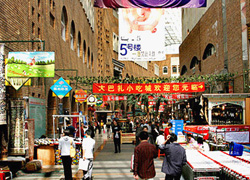 In the morning you will visit Jiaohe Ruins, an important archaeological site 10km West of Turpan is the remains of an ancient walled capital of the Uighur with its large monastery and palace. Then driven to Urumqi, the capital of Xinjiang. On arrival visit Xinjiang Autonomous Region Museum to learn more of Xinjiang and the Silk Road topics at large. Then you will visit Erdaoqiao Bazaar, a bustling market filled with fruit, clothing, crafts, knives, carpets and almost anything that you can imagine. On Sunday, there are more stalls and more goods to buy than any other day. The old streets around the bazaar are really worth seeing. Here is the most welcomed place by tourist especially by ladies where they can buy some traditional Uigur make up cosmetic. | ||
| Day18 Depart Urumqi (B) Transfer to airport for your departure flight. Journey ends. | ||
Tour costing varies upon group size, travel season and hotel accommodation levels etc. For price details please email us at info@splendidchinatours.com.
Price inclusions:
01). All accommodations based on two persons sharing one room/tent (single occupancy is subject to supplement);
02). China internal flights with airport tax or train as stated in the program;
03). Round-trip transfers between airports or railway stations, hotels, and scenic spots in each city by private air-conditioned vehicles with experienced licensed drivers;
04). All admission fees and activity expenses as listed in the itinerary;
05). Daily meals as specified in the itinerary: B denotes breakfast, L denotes lunch, and D denotes dinner (SD signifies special dinner);
06). Services of a seasoned English speaking local trek guide during the walking and for culture visits in the itinerary (other languages can be arranged upon request, supplement may apply);
07). Adequate packing animals such as camels and porters for baggages/outdoor gears during the trekking;
08). Professional outdoor sleeping tents with mattress during the trekking (twin shared basis);
09). Kitchen tent, toilet tent and folding table and chairs during the camping days;
10). Three meals a day prepared by professional outdoor cook during the walking;
11). Travel Agency Liability Insurance during the tour;
12). Governmental taxes and fees.
Price excluded:
01). International airfare to/from China;
02). Chinese Visa fees;
03). Expenses of personal natural such as laundry, telephone, drinks, mini bar etc;
04). Personal shopping, optional activities and excess baggage charges;
05). Gratuities for local tour guides, drivers and hotel bellboy etc;
06). International travel insurance;
07). Services and activities that are not mentioned in the itinerary.
China Trip Planner | Travel Agents | About Us | Why Us | Contact Us | How to Pay | How to Book - Terms & Conditions | Site Map
Copyright © 2010 - 2030 All Rights Reserved.


 0086-28-85711328
0086-28-85711328 0086-28-85546015
0086-28-85546015






